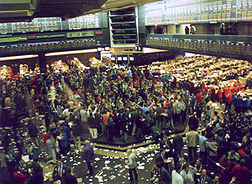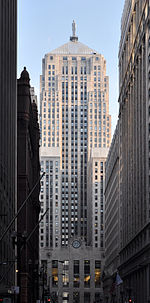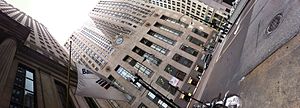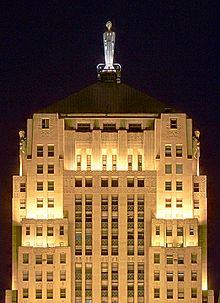- Chicago Board of Trade
-
Coordinates: 41°52′40″N 87°37′56″W / 41.877821°N 87.632285°W
Chicago Board of Trade 
Type Subsidiary Industry Business Services Founded 1848 Headquarters Chicago, Illinois Products Options/Futures exchange Owner(s) CME Group The Chicago Board of Trade (CBOT), established in 1848, is the world's oldest futures and options exchange. More than 50 different options and futures contracts are traded by over 3,600 CBOT members through open outcry and eTrading. Volumes at the exchange in 2003 were a record breaking 454 million contracts. On 12 July 2007, the CBOT merged with the Chicago Mercantile Exchange (CME) to form the CME Group, a CME/Chicago Board of Trade Company. CBOT and three other exchanges (CME, NYMEX, and COMEX) now operate as designated contract markets (DCM) of the CME Group.[1]
Contents
History
 Trading floor at the Chicago Board of Trade in 1993.
Trading floor at the Chicago Board of Trade in 1993.
The concerns of U.S. merchants to ensure that there were buyers and sellers for commodities have resulted into forward contracts to sell and buy commodities. Still, credit risk remained a serious problem. The CBOT took shape to provide a centralized location, where buyers and sellers can meet to negotiate and formalize forward contracts.
In 1864, the CBOT listed the first ever standardized "exchange traded" forward contracts, which were called futures contracts. In 1919, the Chicago Butter and Egg Board,[2] a spin-off of the CBOT, was reorganized to enable member traders to allow future trading, and its name was changed to Chicago Mercantile Exchange (CME).
On October 19, 2005, the initial public offering (IPO) of 3,191,489 CBOT shares was priced at $54.00 (USD) per share. On its first day of trading the stock closed up +49% at $80.50 (USD) on the NYSE.
In 2007, the CBOT and the CME merged to form the CME Group.
The Merger
A merger of the CBOT and CME had been a matter of common speculation for many years before it actually came to pass.
The Building
Main article: Chicago Board of Trade BuildingSince 1930, the Chicago Board of Trade has been operating out of 141 West Jackson Boulevard, Chicago. It is housed in a building designed by architects Holabird & Root that is 605 feet (184 m) tall, the tallest in Chicago until the Richard J. Daley Center superseded it in 1965. This Art Deco building incorporates sculptural work by Alvin Meyer and is capped by a 31 foot (9.5 m) tall statue of the Roman goddess Ceres in reference to the exchange's heritage as a commodity market. Ceres is faceless because its sculptor, John Storrs, believed that the forty-five story building would be sufficiently taller than any other nearby structure and as a result that no one would be able to see the sculpture's face anyway.
On May 4, 1977, the Chicago Board of Trade Building was designated a Chicago Landmark.[3] The building is now a National Historic Landmark. Today the Board of Trade Building is closely joined by numerous skyscrapers in the heart of Chicago's busy Loop commercial neighborhood.
Trading platforms
The Pit
The pit is a raised octagonal structure where open-outcry trading takes place. Operating during regular trading hours (RTH), the CBOT trading floor contains many such pits.
The steps up on the outside of the octagon and the steps down on the inside give the pit something of the appearance of an amphitheater, and allow hundreds of traders to see and hear each other during trading hours. The importance of the pit and pit trading is emphasized by the use of a stylized pit as the logo of the CBOT. "The Pit" is also the title and subject of a classic novel (1903) by Frank Norris.[4]
Trades are made in the pits by bidding or offering a price and quantity of contracts, depending on the intention to buy (bid) or sell (offer).
This is generally done by using a physical representation of a trader's intentions with his hands. If a trader wants to buy ten contracts at a price of eight, for example, in the pit he would yell "8 for 10", stating price before quantity, and turn his palm inward toward his face, putting his index finger to his forehead denoting ten; if he were to be buying one, he would place his index finger on his chin. If the trader wants to sell five contracts at a price of eight, they would yell "5 at 8", stating quantity before price, and show one hand with the palm facing outward, showing 5 fingers. The combination of hand-signals and vocal representation between the way a trader expresses bids and offers is a protection against misinterpretation by other market participants. For historical purposes, an illustrated project to record the hand signal language used in CBOT's trading pits has been compiled and published.[5]
With the rise of electronic trading the importance of the pit has decreased substantially for many contracts though the pit remains the best place to get complex option spreads filled.
Electronic trading
Electronic trading platforms operate virtually around the clock.
News lines
- On August 1, 1974, trading at The Chicago Board of Trade was halted after an anonymous caller said a bomb had been placed in the building.
- On October 22, 1981, trading was halted on the Chicago Board of Trade and the Philadelphia Stock Exchange after anonymous callers said bombs had been placed in those buildings.
- On August 1, 2006, the CBOT launched side-by-side trading for agricultural futures. Orders can now be traded electronically or placed by pit traders using open outcry, creating a single pool of liquidity.
- On October 17, 2006, the Chicago Mercantile Exchange announced the purchase of the Chicago Board of Trade for $8 billion in stock, joining the two financial institutions as CME Group, Inc. CBOT currently uses outsourced technology platforms, but will move to CME's Globex trading system. This will provide much of the merger's anticipated savings. The merger will also strengthen the combined group's position in the global derivatives market.
- On July 9, 2007 CBOT Shareholders approve merger with the Chicago Mercantile Exchange "creating the largest derivatives market ever." [6]
See also
- Commodity Exchange Act
- Horatio G. Loomis
- List of futures exchanges
- List of traded commodities
- New York Mercantile Exchange
- Board of Trade of City of Chicago v. Olsen 262 U.S. 1 (1923)
- Chicago Board of Trade v. Christie Grain 198 U.S. 236 (1905)
References
- ^ http://www.cmegroup.com
- ^ http://www.cme.com/about/ins/caag/opebusines2798.html
- ^ http://www.ci.chi.il.us/Landmarks/B/BoardTrade.html
- ^ http://www.gutenberg.org/etext/4382
- ^ "TradingPitHistory.com". CBOT Trading Pit Hand Signals. http://tradingpithistory.com/.
- ^ "Topic Galleries - chicagotribune.com". Chicago Tribune. http://www.chicagotribune.com/business/chi-070709cbotvote,1,2355812.story.
- Durica, Dr. Michael (2006). Product Development for Electronic Derivative Exchanges: The case of the German ifo business climate index as underlying for exchange traded derivatives to hedge business cycle risk. Pro Business. Berlin. ISBN 10: 3-939533-05-X.
- Ryan, Oliver (Nov. 14, 2005). "Chicago's Making A Contracts Killing". FORTUNE, p. 22.
Further reading
- Emily Lambert (2011). The Futures: The Rise of the Speculator and the Origins of the World's Biggest Markets. Basic Books.
- Erika Olson (2011). Zero-Sum Game: The Rise of the World's Largest Derivatives Exchange. John Wiley & Sons.
External links
- Chicago Board of Trade
- TradingPitHistory.com A website to preserve the trading pit hand signals used at CBOT
- Chicago Landmarks: Chicago Board of Trade Building[dead link]
- Chicago Board of Trade Membership overwhelmingly approves restructuring
- CME Group
- Commodities Trader at the Chicago Board of Trade
- News on the Merger: Chicago bulls
Categories:- Commodity exchanges in the United States
- Companies based in Chicago, Illinois
- Economy of Chicago, Illinois
Wikimedia Foundation. 2010.



